Monday, February 20, 2017
Art Space vs. Work Space
I did pretty well, too. I got rid of two sets of old dishes, innumerable gadgets, old flower vases, pans, pots, and three small appliances. I wasn't sorry to see things like the 20-year-old blooming onion maker drop in the donation box (I haven't used it since the nineties.) At the same time, I couldn't let go of my daughter's Where's Waldo plastic cereal bowl, which I can guarantee you she will never use again. That bowl is for me and my memories of her in her high chair, dropping Cheerios for our dog Missy when she thought I wasn't watching.
Cooking is work, but it's also an art. When it comes to meal preparation, the kitchen is both work space and studio. Having a spotless, well-organized kitchen now will help me be a better and happier cook, which will result in more creative meals. Since I'll be cooking only for two starting this fall, I definitely need that, but it's also about respecting myself. I work every day in the kitchen, and it should be a space that allows me to do that comfortably and well.
Next on the spring cleaning list is my office, which I've let slide over the past couple of months because I've been so busy. I could let it wait until summer, or do it a little at a time, which is also perfectly acceptable. Thing is, I have some new, significant writing projects coming up on the schedule, and I need the office to be as clean, efficient and uncluttered as the kitchen is now.
Whether it's cooking or writing, I'm always happy to go to work. I'm not very conscious of my work space when I do. That said, I feel better when everything around me is tidy. I think I work better, too.
What's on your spring cleaning list for 2017? How are you going to tackle your projects? Let us know in comments.
Thursday, October 25, 2012
NaNoWriMo Countdown: Work Space
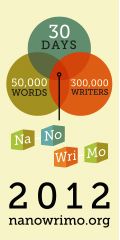 I can write just about anywhere, and I know this because I have. I started writing for publication on one corner of our dining room table. I've also written in coffee shops and hotels, lobbies and waiting rooms, in cars and on airplanes, in physical therapy whirlpools and once (rather memorably) while I was a patient in Labor & Delivery. Nineteen hours of labor is long and exhausting and utterly devoid of fun, especially when you elect to do it completely naturally. They don't let you order in pizza, either, but if you plan ahead you can your guy smuggle it in between nurse checks. To me extra pepperoni is way more soothing than chipped ice and back rubs . . . but I digress.
I can write just about anywhere, and I know this because I have. I started writing for publication on one corner of our dining room table. I've also written in coffee shops and hotels, lobbies and waiting rooms, in cars and on airplanes, in physical therapy whirlpools and once (rather memorably) while I was a patient in Labor & Delivery. Nineteen hours of labor is long and exhausting and utterly devoid of fun, especially when you elect to do it completely naturally. They don't let you order in pizza, either, but if you plan ahead you can your guy smuggle it in between nurse checks. To me extra pepperoni is way more soothing than chipped ice and back rubs . . . but I digress.Where your writing space is, how large it is or how much you can fit into it doesn't matter as much as making it work for you. Once I turned pro I definitely needed a dedicated work space, but at the time we had no spare rooms I could make into an office. My solution was to invest in a rolling computer stand. I figured with it I could make my writing space portable and move it to whatever area in the house was unoccupied.
It worked great. I usually kept the stand in a corner of the living room or our bedroom, but when things got noisy I'd roll it out on the porch. One winter when we had a lot of house guests I took it out in the garage and worked there for two months. All I really needed was a quiet place with an electrical outlet, and I was good to go.
When you think about creating or changing your work space you might consider what is the ideal working atmosphere for you. If you write best in a quiet space, look around your home for a spot away from areas your family most often use. Some writers choose to work in spare bedrooms or garages; I read an article recently about one novelist who turned a walk-in closet into a work space. Others choose to write in attics and outdoor sheds. Many public libraries offer quiet rooms where you can get some work done, too.
If you write best in a public place like a park, mall or coffee shop you should try out a couple and see where you're most productive. I often like to go to the park with a bag lunch for a writing session, especially now when the cooler weather is chasing off the bugs. You should also look at how accessible your favorite public spot is when you need to write; some may be closed or too crowded during the times you plan to work.
If home is too busy and public places are too distracting, you might check with family, friends or your place of worship and see if you can borrow one of their spare rooms as a temporary work space. Churches are often happy to lend you a quiet room in exchange for a minimal fee or even some volunteer time. If you have a day job and a friendly boss, see if you can stay after work to write at your desk or in one of the offices for an hour or two. When I worked a day job I used to spend my lunch hour writing in the back storeroom (and since I was a bookseller being surrounded by all those boxes of new arrivals was very motivating.)
In what sort of space are you most productive with your writing? Have you found any great alternatives that might work for other writers in need of space? Let us know in comments.
Friday, January 07, 2011
Reading Spaces
Now if the take-a-seat came with a little side-arm desk to use for a notepad, laptop or other writing gadget, it might just be the perfect portable writing space that never lets you wander away from it.
While the idea of a robot chair is fun, I've been looking at more no-tech devices to help me out with the work. I mentioned on the photoblog last year that a plastic clear-fronted cookbook holder doubled nicely as a holder for a pattern book. I also regularly use Gimbles. My current problem is propping up books to read from them; my hands get tired pretty fast these days, and my trifocals it hard to read from a book that's flat on the desk for any length of time.
Recently I was at BAM and decided to pick up these three gadgets and try them out:
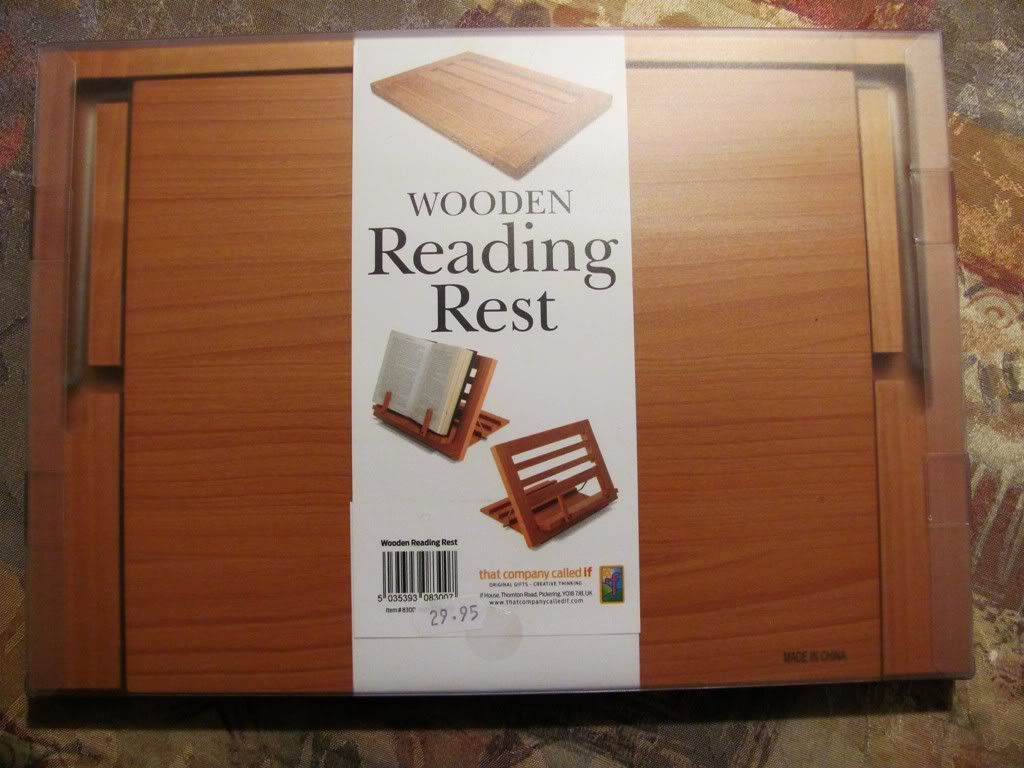 This Wooden Reading Rest (made by that company called if) is 13-1/2" X 9-1/2", and folds completely flat to 3/4". The back of the rest adjusts to three different positions to give you a choice of viewing angles, and does hold large/heavy hardcover books. There are also two small movable pegs at the bottom to keep the pages in place. It's also a nice holder for a book you want to display opened.
This Wooden Reading Rest (made by that company called if) is 13-1/2" X 9-1/2", and folds completely flat to 3/4". The back of the rest adjusts to three different positions to give you a choice of viewing angles, and does hold large/heavy hardcover books. There are also two small movable pegs at the bottom to keep the pages in place. It's also a nice holder for a book you want to display opened.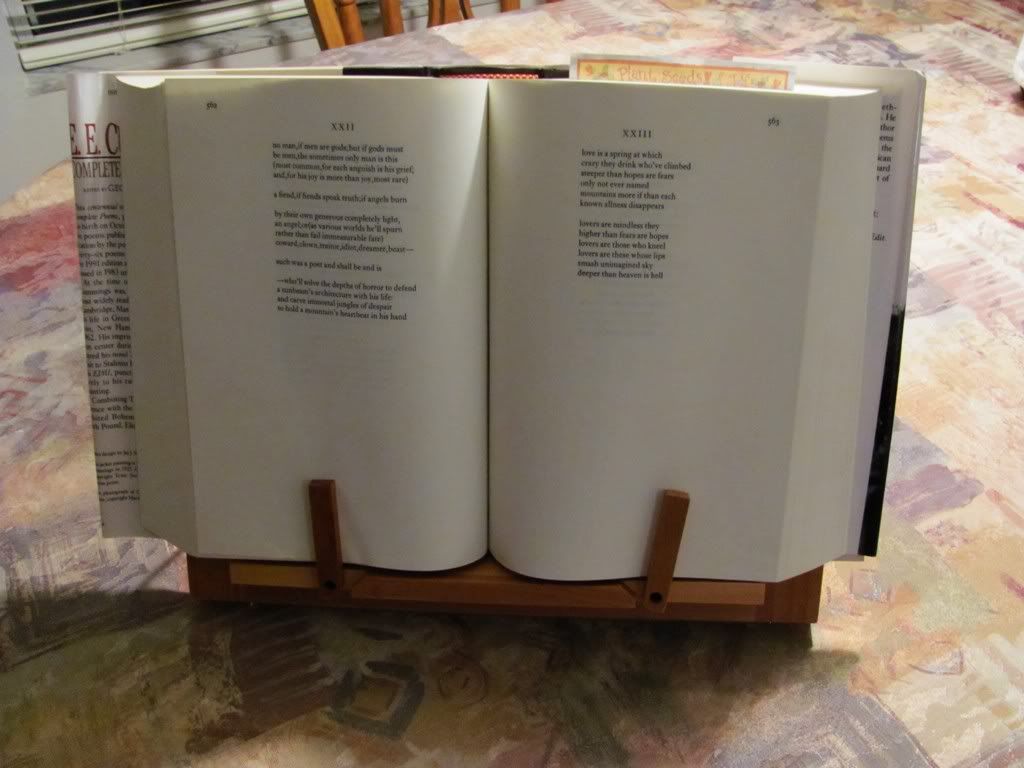 The main problem I had with this one is the page space allowance in the width of the holder; the page holder pegs are screwed in place and not adjustable, so they can't be used if you're looking in the back pages of a very thick book. I'm going to write to the company and suggest they put the pegs on sliders so they can be adjusted out as well as up and down. Also, while it appears to be well made, I thought the price at $29.95 was a bit high. For what you get, I felt $10.00 - $15.00 would be more reasonable. Maybe they should make it out of something less expensive than Canadian Alder wood.
The main problem I had with this one is the page space allowance in the width of the holder; the page holder pegs are screwed in place and not adjustable, so they can't be used if you're looking in the back pages of a very thick book. I'm going to write to the company and suggest they put the pegs on sliders so they can be adjusted out as well as up and down. Also, while it appears to be well made, I thought the price at $29.95 was a bit high. For what you get, I felt $10.00 - $15.00 would be more reasonable. Maybe they should make it out of something less expensive than Canadian Alder wood.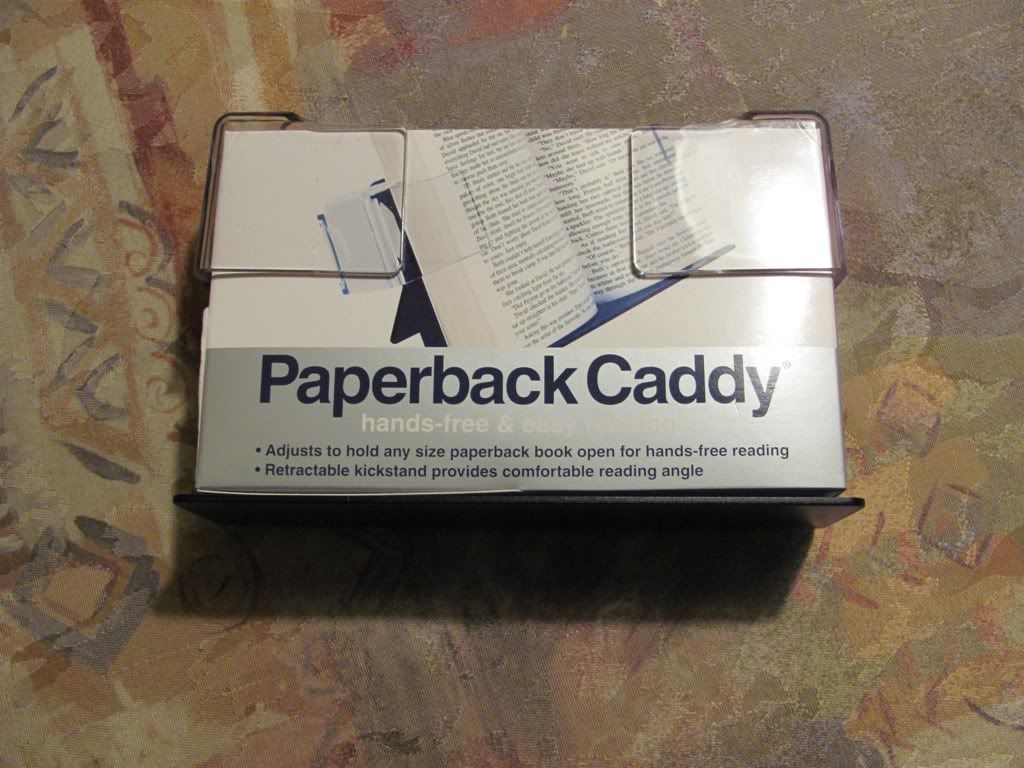 The Paperback Caddy (there are any number of book rests using the same name; this one was made by Great Point Light) is also intended for hands-free reading, although as the name says, strictly for paperback books. It does hold any size paperback from mass market to trade, as the clear outer arms slide in and out for adjustment. It's also small -- with the arms pushed in, about 7-1/2" X 4-1/2" -- and made of lightweight plastic, with a kickstand in the back to provide support and give you two different reading angles.
The Paperback Caddy (there are any number of book rests using the same name; this one was made by Great Point Light) is also intended for hands-free reading, although as the name says, strictly for paperback books. It does hold any size paperback from mass market to trade, as the clear outer arms slide in and out for adjustment. It's also small -- with the arms pushed in, about 7-1/2" X 4-1/2" -- and made of lightweight plastic, with a kickstand in the back to provide support and give you two different reading angles.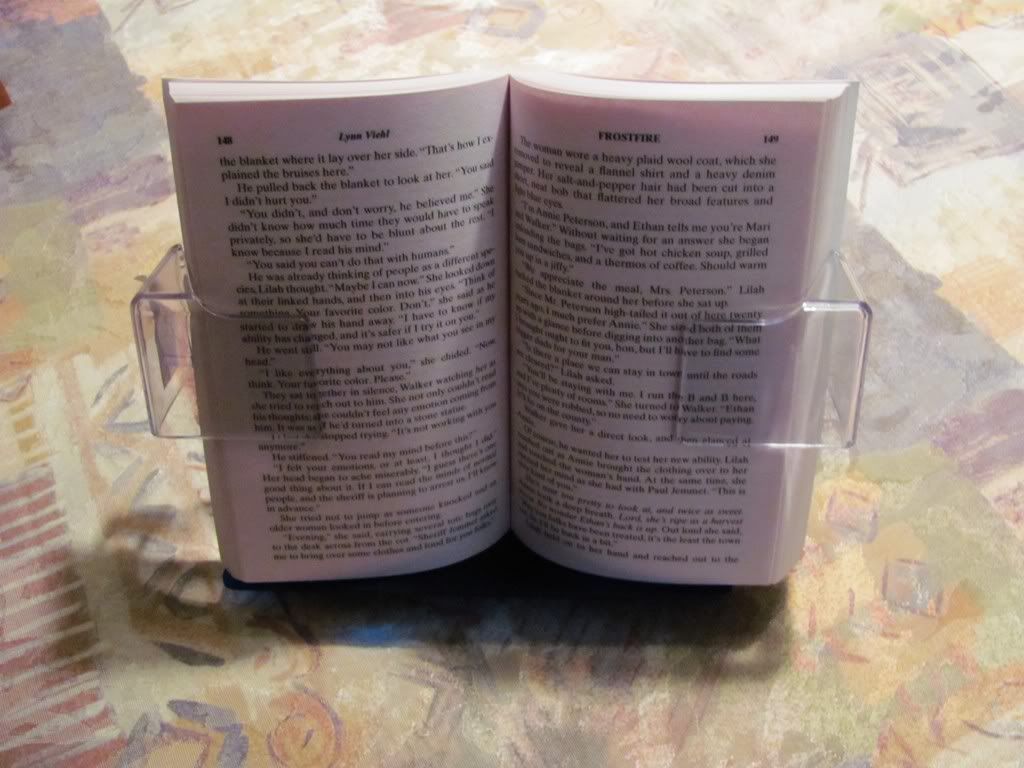 The company claims on the packaging that the Paperback Caddy is "Designed for one-touch page turning." If that's true whoever designed it screwed up, then, because I had to use both hands. Getting the page I was turning tucked under the arm was difficult enough to make me almost wrinkle the page in the process. Just to be sure it wasn't being caused by me and my lack of dexterity, I had a fully-abled friend try it, and she had the same difficulty. I also felt this one was overpriced at $12.95, considering how troublesome turning the pages were, as well as the quality of the plastic (the arms are pretty sturdy, but the back component is thin and cheap, and I'm not sure how long that kickstand is going to last.)
The company claims on the packaging that the Paperback Caddy is "Designed for one-touch page turning." If that's true whoever designed it screwed up, then, because I had to use both hands. Getting the page I was turning tucked under the arm was difficult enough to make me almost wrinkle the page in the process. Just to be sure it wasn't being caused by me and my lack of dexterity, I had a fully-abled friend try it, and she had the same difficulty. I also felt this one was overpriced at $12.95, considering how troublesome turning the pages were, as well as the quality of the plastic (the arms are pretty sturdy, but the back component is thin and cheap, and I'm not sure how long that kickstand is going to last.)  The PageKeeper (by Pagekeeper Inc.) bills itself on the front of its blister packaging as "The Amazing Automatic Bookmark!" that "follows you from page to page." I'm pretty sure it was invented by someone sitting in a cubicle and messing around with a money clip and a bent paperclip, because that basically describes the entire product. You slide the money clip part to the back cover of your book, and position the bent paperclip part over the last page you've read. When you open the book and want to turn the page, you just slide it out from under the bent paperclip and it clutches the next page until you're ready to turn it.
The PageKeeper (by Pagekeeper Inc.) bills itself on the front of its blister packaging as "The Amazing Automatic Bookmark!" that "follows you from page to page." I'm pretty sure it was invented by someone sitting in a cubicle and messing around with a money clip and a bent paperclip, because that basically describes the entire product. You slide the money clip part to the back cover of your book, and position the bent paperclip part over the last page you've read. When you open the book and want to turn the page, you just slide it out from under the bent paperclip and it clutches the next page until you're ready to turn it.This one actually did exactly what the manufacturer promised, fitting snugly to the back cover and keeping my place marked with the bent paperclip thing. It was also easy to free up the page I wanted to turn, and the clip didn't fall off or move much at all when I did. For that reason I got over the rather startling price of $6.95; I don't mind paying a little more for a simple invention that actually does what the package says it will.
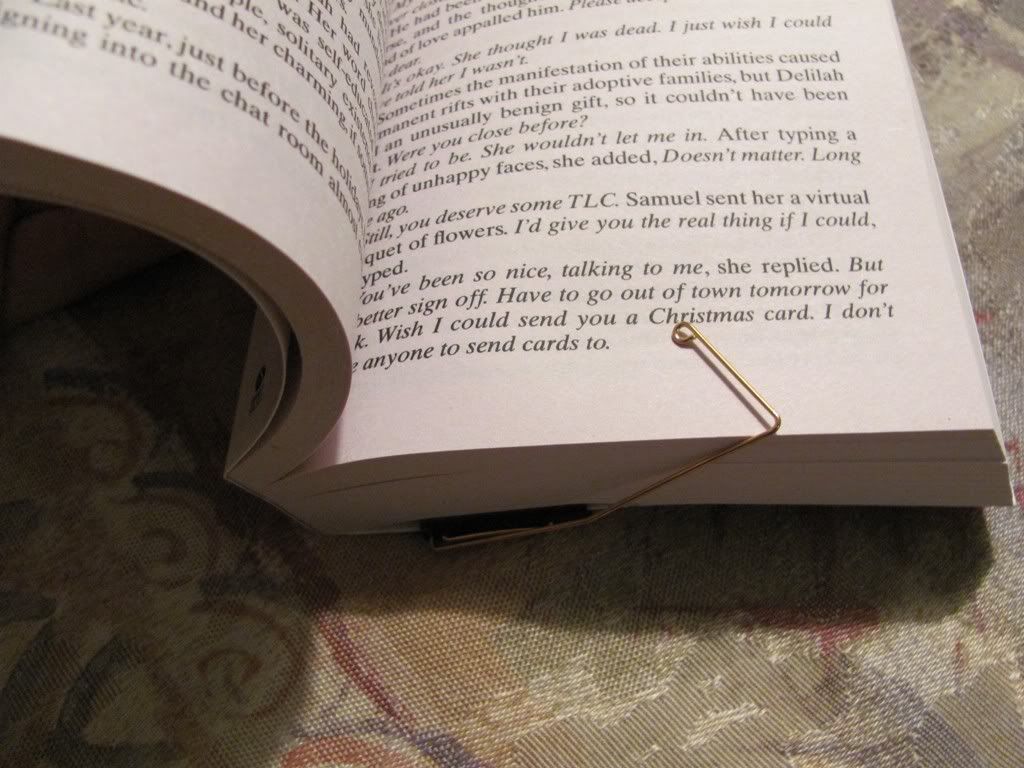 I think the main drawback to this gadget is its limitations. It's designed to be a bookmark, not a book holder, so it won't keep the book open for you or do anything about the pages you've already read. Also it doesn't work on marking the front pages of huge thick books; the bent paperclip part doesn't stretch that far. I also wonder how long the snugness of the back cover clip will last with constant use. But if you're one of those readers that for whatever reason endures paper bookmarks constantly falling out of your books, then this is one possible solution to your problem.
I think the main drawback to this gadget is its limitations. It's designed to be a bookmark, not a book holder, so it won't keep the book open for you or do anything about the pages you've already read. Also it doesn't work on marking the front pages of huge thick books; the bent paperclip part doesn't stretch that far. I also wonder how long the snugness of the back cover clip will last with constant use. But if you're one of those readers that for whatever reason endures paper bookmarks constantly falling out of your books, then this is one possible solution to your problem.Have you guys noticed any new/exciting no-tech gadgets out there for books? Let us know in comments.
Tuesday, June 17, 2008
Outer, Inner Spaces
 One of the reasons I picked up A Writer's Space ~ Make Room to Dream, to Work, to Write is because it was written by Dr. Eric Maisel, the author of one of my all-time favorite inspirational nonfic books, A Writer's Paris. I was also curious to see what he had to say about writing spaces, the birthplace of every book in existence.
One of the reasons I picked up A Writer's Space ~ Make Room to Dream, to Work, to Write is because it was written by Dr. Eric Maisel, the author of one of my all-time favorite inspirational nonfic books, A Writer's Paris. I was also curious to see what he had to say about writing spaces, the birthplace of every book in existence.
The first 10 chapters of the book address the physical writing space, as well as how to find, regard, respect, manage and protect it. Lots of good advice as well as several exercises at the end of every section to help put theory into action (don't be intimidated by the number of chapters; they're short and the book is only 248 pages in length.)
While reading I learned that I'm not alone in needing a very small, completely uncluttered place to write; evidently Amy Tan has the same problem. Dr. Maisel mentioned some other, interesting famous writer quirks: James Joyce preferred to write in bed; Isaac Asimov had several typewriters set up on tables around his office (one for each project). Alice Hoffman goes so far as to paint her office a different color every time she starts a new book, using a shade that resonates with the book's theme (good thing this isn't my little quirk.)
The next 25 chapters of the book, however, deal with the writing spaces less apparent to the rest of the world: mind, emotional, reflective, imagined, public, and even existential. Here Dr. Maisel discusses things most writers wrestle with in private, like envy, depression, dissatisfaction, coping with rejection, the weight of individuality (chapter 16, the story of my life) and how destructive they can be to the writer as well as the work if left unchecked.
Chapters 26-28 deals with how the writer should handle public spaces (for blogging writers, that's the internet) and this is where I thought Dr. Maisel was being a bit naive at times. He encourages the writer to stand up, speak out, and not be so nice while he downplays (or really isn't aware of) the risks involved for today's working writer. Here I would have liked to see a couple of chapters on how to handle those brave, usually anonymous souls who decide you and your public-accessible space are their personal soapbox, punching bag or restroom.
Aside from that one blip, the book is quite good, which I expected, and chock full of new ways and means of dealing with all these different writer spaces, which I didn't. I've imprinted myself with several phrases I'm probably going to use way too much now, like emotional intelligence (chapter 15).
As always, you don't have to take my word for it. In comments to this post, describe your ideal space for writing (or if you're comfortable working anywhere and everywhere, just toss your name into the hat) by midnight EST on Wednesday, June 18, 2008. I'll draw five names at random from everyone who participates, and send the winners an unsigned copy of A Writer's Space by Dr. Eric Maisel. This giveaway is open to everyone on the planet, even if you've won something here at PBW in the past.
